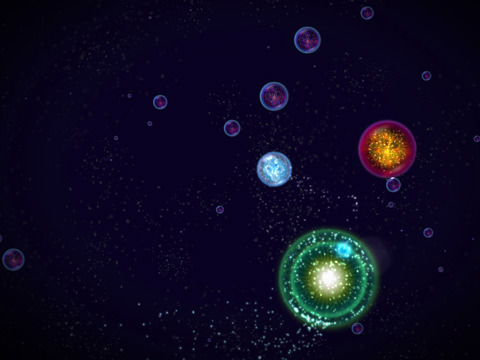 Osmos was originally released in late August of 2009 for the PC, and went on to win numerous Editor’s Choice awards as it was initially reviewed, then was awarded further at both the Independent Games Festival, PAX, and even the Spike TV 2009 Video Game Awards. In fact, if you want to see just how much the gaming media loves Osmos, take a peek at their web site where they’ve got links to a ridiculous amount of reviews with all of them near the top of the scale each media outlet used.
Osmos was originally released in late August of 2009 for the PC, and went on to win numerous Editor’s Choice awards as it was initially reviewed, then was awarded further at both the Independent Games Festival, PAX, and even the Spike TV 2009 Video Game Awards. In fact, if you want to see just how much the gaming media loves Osmos, take a peek at their web site where they’ve got links to a ridiculous amount of reviews with all of them near the top of the scale each media outlet used.
As I mentioned when we first heard about the game coming to the iPad, it didn’t take much more than a few seconds of playing the game on my computer to realize just how well it could work on the iPad. I’m happy to report that my suspicions were correct, and Osmos for iPad [$4.99] is a fantastic fit for the device. To get players up to speed on the iPad, Osmos includes “Odyssey mode" which is a 27 level tutorial of sorts which will walk you through everything there is to know about the game.

Osmos has a wide variety of different level types, which all revolve around one common theme: Be the biggest. You control a tiny organism called a “mote". By tapping in a direction, you expel mass towards where you tapped, and your mote goes zooming off the other direction. With each tap you lose a little bit of your mass, so it doesn’t take long before you’re making extremely calculated taps to get exactly where you want to go with minimal loss of size. Your mote can absorb any mote that it smaller than it, but it also can be absorbed by any mote that is larger than it. You can also zoom in or out using a pinching gesture.
 This gameplay mechanic works extremely well on the iPad, and is expertly paired with some fantastic mellow electronica that does a great job of setting the mood of the game. Initially levels simply ask you to be the biggest, but it doesn’t take long until Osmos throws other level types at you such as levels where everything is orbiting around a central mass and you must carefully expel your own mass to change your orbit to absorb other motes as well as levels that require you to capture a specific mote.
This gameplay mechanic works extremely well on the iPad, and is expertly paired with some fantastic mellow electronica that does a great job of setting the mood of the game. Initially levels simply ask you to be the biggest, but it doesn’t take long until Osmos throws other level types at you such as levels where everything is orbiting around a central mass and you must carefully expel your own mass to change your orbit to absorb other motes as well as levels that require you to capture a specific mote.
These levels are my favorite as the “enemy mote" (if you’d even call it that) is also trying to absorb anything smaller than it to get bigger than you to munch your mote up. Since there are only so many smaller motes around for you to absorb initially, these levels turn in to a really fun race for motes you can absorb while avoiding larger ones that will absorb you, and finally absorbing your target mote.
In all, eight different levels types are included, which all have their own unique mechanic centralized around the physics engine powering Osmos. You can even speed up or slow down time by swiping the screen, a function that becomes very handy in later levels when you need time for precise movements. Following the completion of Odyssey mode, arcade mode is unlocked which allows you to play any level type on whatever difficulty level you choose. OpenFeint is even bundled in for tracking the various in-game achievements.
If you’re curious about Osmos, there isn’t a lite version, but there’s a free demo for Windows, OSX, and Linux available on the Osmos web site. Overall, Osmos is a great experience, and while I’m still waiting for a game that feels like it could only exist on the iPad, Osmos is definitely a game that feels a whole lot better on the device.
